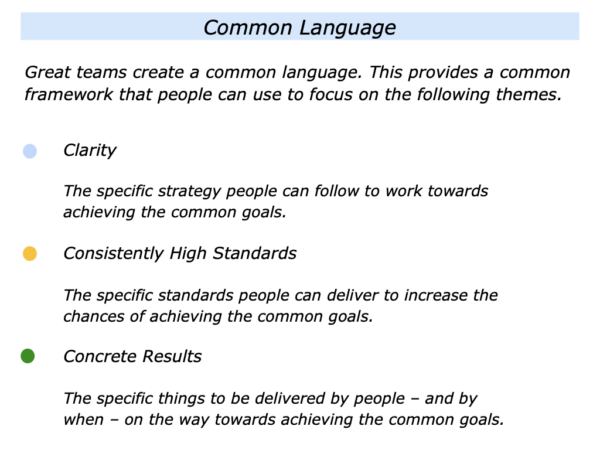
Winston Churchill said that first we shape our buildings, then our buildings shape us. When I began working with people, I was told:
“First we shape our language, then our language shapes us.”
Great teams often a common language. This is an approach I have seen work in education, sports, business and organisations. It provides a common framework that people can use to focus on the following themes.
Clarity
The specific strategy people can follow to work towards achieving the common goals.
Consistently High Standards
The specific standards people can deliver to increase the chances of achieving the common goals.
Concrete Results
The specific things to be delivered by people – and by when – on the way towards achieving the common goals.
Great teams create a language that provides a kind of shorthand people can use to make decisions and translate these into action. Some teams embody this language in certain principles – or values – that they encourage people to follow when working towards the team’s goals.
Different teams will, of course, use different kinds of language. The following sections look at how some people apply this approach in their chosen fields.
The Development
Programmes Approach
The first time I encountered the common language approach was when working in therapeutic communities. Since then I have seen how the approach works in many organisations that help people to develop.
Many of the successful programmes encourage people to take responsibility for shaping their futures. They also used language that encourages people:
To build on their strengths … To follow strategies that work … To work towards achieving their picture of success.
Some development programmes use positive language that encourages people to work towards their goals. They ensure that people feel able to opt in and go at their own pace. There are some cult-like programmes however, that use language to pressures people in other ways.
The Sports Teams Approach
Many sports teams have their own common language. The leader often sets the tone by describing the principles they want people to follow. They then invite people decide if they want to opt in and contribute to achieving the goals.
Bill Walsh, the American Football coach, followed this approach. He invited all the staff of the San Francisco 49ers to decide if they wanted to deliver certain standards of performance.
If they did then, as the title of his book says, The Score Takes Care Of Itself. The next section describes some of the principles he encouraged people to follow.
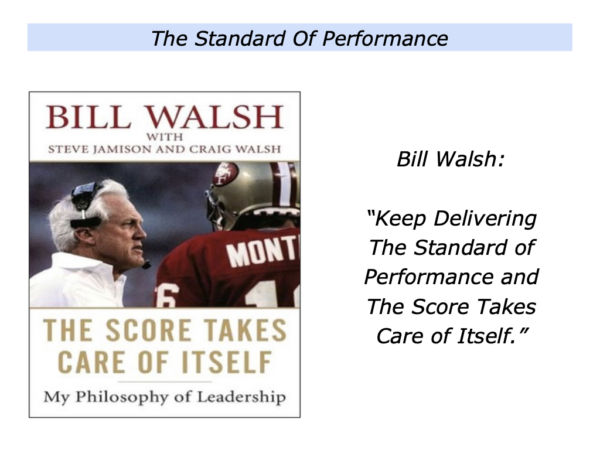
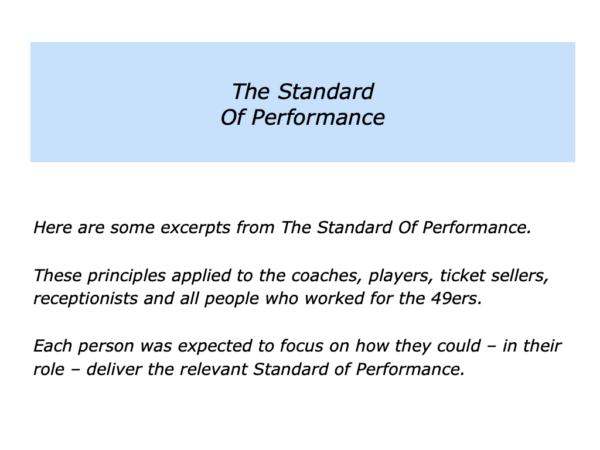
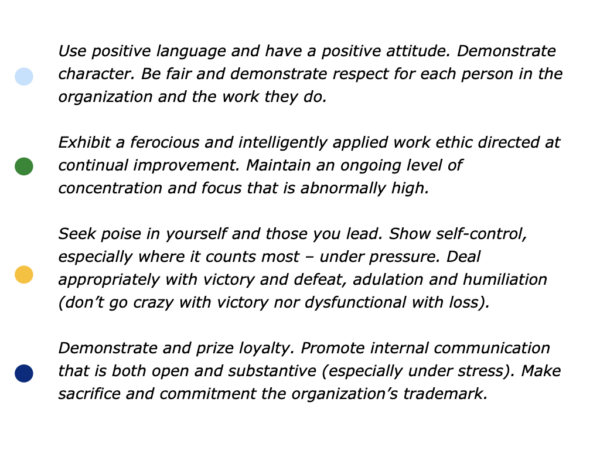
Some coaches outline the principles they want people to follow to achieve the goals. At an appropriate time, they may then invite the players to create their own mantra for pursuing these principles. One common mantra they may produce is:
Be Positive … Be Professional … Be Peak Performers.
Different kinds of sports teams may focus on different kinds of language. Let’s look at another team that took this approach.
The Toshiba Yacht
Crew Approach
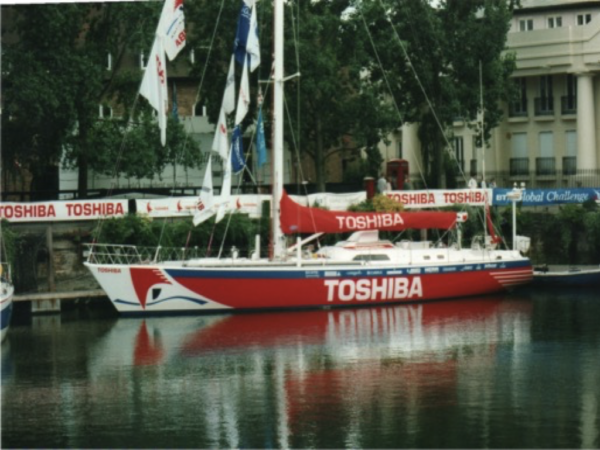
Simon Walker, the skipper of Toshiba, followed elements of this approach when meeting his volunteer crew for the BT Global Challenge. He later described this in the following way.
Different skippers have different approaches. Some immediately go out onto the water; others spend time charting the course ahead.
Immediately after my crew was selected, I arranged for us to get together in a large unheated house in rural Wales.
This was 8 months before the starting gun fired and long before we ever got to sail the yacht. We began by spending two days talking about the race.
You can’t build a team before you’ve agreed on the goal. As the leader, I explained my vision of how our race was to be run, but I also needed people’s ownership.
So we discussed every element of the campaign in detail. Our often repeated values as a crew were simple:
Safe, Happy and Fast.
Professionalism was crucial – because we were literally dealing with matters of life and death. From the outset I insisted on high standards in everything we did and the crew responded superbly.
Time keeping was impeccable. This is important. If you can’t trust your team mate to turn up on time, can you trust him or her with your life?
Simon’s crew kept returning to Safe, Happy, Fast. He describes how these values were translated into action during the storms they encountered.
Everybody’s commitment was crucial. Sailing in the depths of the Southern Ocean, for example, it was icy cold, windy, wet and exhausting.
The people who had finished their watch would go below to snatch some sleep. After 30 minutes spent getting out of soaking kit, they would slide into their mouldy, damp sleeping bag, and it took another 30 minutes to reverse the process.
People therefore only had 3 hours of the 4-hour ‘off-watch’ available for sleep. The crew always slept on the high side of the yacht – which optimised the balance and made it sail faster.
When we needed to tack – change direction – the ‘off-watch’ crew would get up and take their sleeping bag to the other side.
Such a change-over might happen 2 or 3 times during their 3 hours rest. Not a single person complained and the entire crew did this day-after-day across the Southern Ocean.
No leader on Earth could make 13 other exhausted people do this unless they had all bought in into the idea. Everyone was committed.
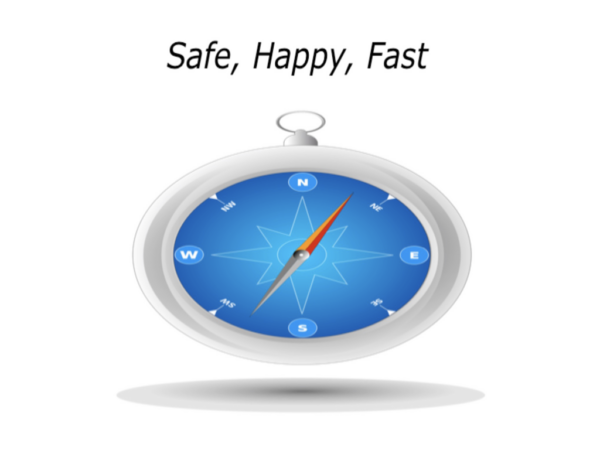
The Organisational Approach
Great organisations choose a language that describes the key principles they want people to follow. Whilst these principles may be eternal, the way people express these may evolve as the world changes.
IBM, for example, was extremely successful for many years. Its people talked about the importance of following what they called the Basic Beliefs. These included:
Respect for the individual … Service to the customer … Excellence in everything we do.
IBM followed these successfully for many years but then hit a wall. The Basic Beliefs still held true but parts of the company did not always translate these into practice.
IBM then revitalised itself by returning to its beliefs and expressing these successfully in the modern world. Kevin Maney, the co-author of Making The World Better, described the reasons for this in the following way.
IBM founder Thomas Watson Sr. realized that if a company is really based on its own set of values, based on what it is rather than what it makes, it allows the company to change with the times.
Some organisations are serious about using a certain language and translating this into action. During the early 1990s I worked with the original leadership team at Air Miles. They created a set of values which were:
Deliver results … Take responsibility … Care for people … Love change.
These words sound fine but are blank cheques. They can mean different things to different people. Bearing this in mind, we involved all their staff in Values In Action Workshops.
The workshops were interactive and enjoyable. They aimed: a) to show how the values were based on when people in the company had done great work; b) to invite people to focus on how the company and its people could translate the values into action.
The sessions also invited people to do an exercise called The Values Challenge. This involved people breaking into groups doing the following things. They aimed:
To focus on a present or future situation that might challenge the values;
To clarify the possible options for tackling the challenge together with the pluses and minuses of each option;
To clarify how people could follow the option that was closest to living the values in that situation.
The exercise showed that sometimes there are no easy answers. The key, however, is to follow the option that is closest to living the values.
Some organisations aim to create a common language. The language they use the help to shape the way people feel, think and act.
When I ran a therapeutic community, we encouraged people to take responsibility for shaping their future. This sometimes involved using the following language when working with the young people:
“How are you choosing to feel today? How do you want to shape your future? How can you work towards achieving your life goals?”
Let’s return to your own life and work. Looking ahead, can you think of a situation where you may want to follow elements of the common language approach? How can you do this in your own way? What may be the benefits of taking these steps?
If you wish, try tackling the exercise on this theme. This invites you to complete the following sentences.
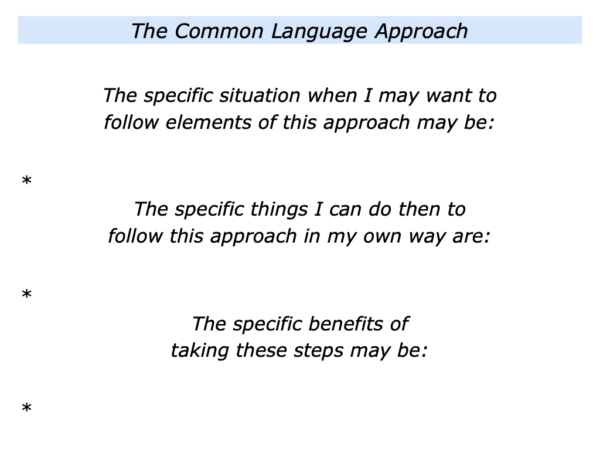






Leave a Reply